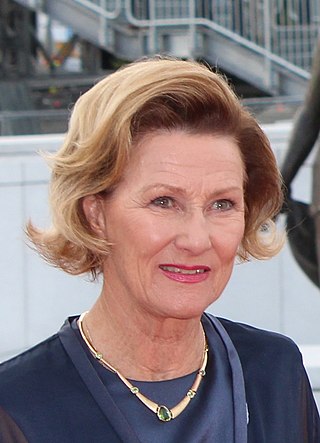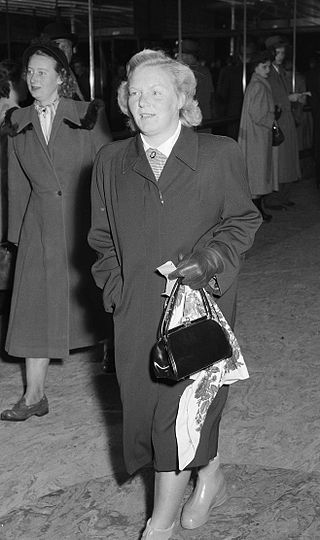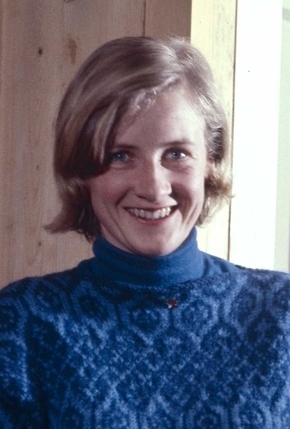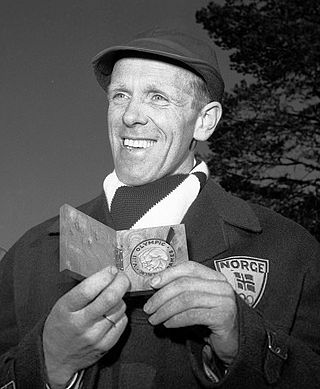
Sonja is Queen of Norway as the wife of King Harald V.

Holmenkollbakken is a large ski jumping hill located at Holmenkollen in Oslo, Norway. It has a hill size of HS134, a construction point of K-120, and a capacity for 70,000 spectators. Holmenkollen has hosted the Holmenkollen Ski Festival since 1892, which since 1980 have been part of the FIS Ski Jumping World Cup and 1983 the FIS Nordic Combined World Cup. It has also hosted the 1952 Winter Olympics and the FIS Nordic World Ski Championships in 1930, 1966, 1982 and 2011.

Olav Bjaaland was a Norwegian ski champion and polar explorer. In 1911, he was one of the first five men to reach the South Pole as part of Amundsen's South Pole expedition.

Bjørn Tore Wirkola is a Norwegian former ski jumper.

Lauritz Bergendahl was a Norwegian Nordic skier who won both the Nordic combined and the 50 km cross-country skiing events at the Holmenkollen ski festival in 1910, 1912, 1913, 1914, and 1915. Bergendahl's Holmenkollen 50 km cross-country skiing victories have only been exceeded by one skier while his Holmenkollen Nordic combined victories have been matched by three others. Bergendahl earned the Holmenkollen medal in 1910 while his nephew Lars earned the honor in 1939.

Borghild Niskin was a Norwegian alpine skier who finished 7th in the women's giant slalom at the 1956 Winter Olympics at Cortina d'Ampezzo. She became the first woman awarded the Holmenkollen medal that same year.
Inger Bjørnbakken was a Norwegian alpine skier.

Astrid Sandvik is a Norwegian Alpine skier who finished tied for sixth place in the women's slalom at the 1956 Winter Olympics in Cortina d'Ampezzo. In 1963, Sandvik was awarded the Holmenkollen medal. Sandvik is one of only eleven non-Nordic skiers to win the Holmenkollen medal.

Håkon Brusveen was a Norwegian cross-country skier. He competed in the individual 15 km and 4 × 10 km relay events at the 1956 and 1960 Olympics and won two medals in 1960: a gold in the 15 km and a silver in the relay; in 1956 he placed fifth and fourth, respectively. In 1958 he was awarded the Holmenkollen medal, and in 1960 the Morgenbladet Gold Medal. A freelance sports broadcaster for NRK for 35 years, he was a pioneering color commentator of cross-country skiing events.

The FIS Nordic World Ski Championships 2011 took place from 23 February to 6 March 2011 in Oslo, Norway, at the Holmenkollen National Arena. It was the fifth time these championships had been hosted in Holmenkollen, having been done previously in 1930, the 1952 Winter Olympics, 1966, and 1982. On 25 May 2006, the 45th FIS Congress in Vilamoura, Portugal, selected the Holmenkollen area over both Val di Fiemme, Italy, and Zakopane, Poland, with a vote of 12 to 4 to 0. These games coincided with the Holmenkollen Ski Festival as they have previously in 1930, 1952, 1966, and 1982.

Jacob Ulrich Holfeldt Tostrup was a Norwegian jeweler, goldsmith and silversmith.
Events in the year 2001 in Norway.

Nordstrand Idrettsforening is a sports club in Nordstrand, Oslo, Norway. The club has sections for alpine skiing, association football and handball. It formerly had sections for orienteering, track and field and Nordic skiing. The club colors are white and blue.

Skiklubben Ull was a Norwegian Nordic skiing club based in Oslo. Founded in 1883, Skiklubben Ull attracted several skilled sportsmen who between 1883 and 1891 won six Ladies' Cups and one King's Cup in national skiing events. The sporting facilities belonging the club were located in Vestre Aker, with the ski jumping hill Ullbakken near Frognerseteren being opened in 1884. The prestigious Husebyrennet was staged there once. Members of SK Ull were later instrumental in moving this prestigious contest to the hill Holmenkollbakken.

Nicolay Fritz Reichwein Huitfeldt was a Norwegian sports official, writer and producer of skis and ski bindings.

Karl Nikolai Roll was a Norwegian sports official, skier and military officer.

The Royal Lodge or The Royal Villa is located in Holmenkollen in Oslo, Norway, and is in the Norwegian royal family's private possession. The property is used mainly in winter, and the royal family usually celebrates Christmas there, and stays at the Royal Lodge during the Holmenkollen Ski Festival every year.

Nikolai Ramm Østgaard, sometimes referred to as N. R. Østgaard, was a Norwegian military officer, aide-de-camp for Olav V of Norway, and sports official who is best known as President of the International Ski Federation (FIS) from 1934 to 1951.

The King's Choice is a 2016 biographical war film directed by Erik Poppe. It is a co-production of Norway, Sweden, Denmark, and Ireland, and was selected as the Norwegian entry for the Best Foreign Language Film at the 89th Academy Awards. The film made the shortlist of nine films to be considered for a nomination at the 89th Academy Awards.

The Holmenkollen 50 km is an annual cross-country skiing race held at Holmenkollen National Arena in Oslo, Norway. The competition is part of the Holmenkollen Ski Festival. Previous to 2023 The 50 km distance is raced by men only as the women's equivalent is a 30 km race. Starting in 2023 both men and women will race 50k.


















